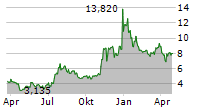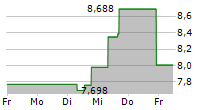
Topline ATTENTION-AD trial: Patients showed improved cognition and function over three years
Delayed-start analysis of treatment with oral blarcamesine was significant reflecting importance of early treatment initiation
Blarcamesine exhibited a favorable safety profile with no treatment-related deaths
NEW YORK, Jan. 13, 2025 (GLOBE NEWSWIRE) -- Anavex Life Sciences Corp. ("Anavex" or the "Company") (Nasdaq: AVXL), a clinical-stage biopharmaceutical company focused on developing innovative treatments for Alzheimer's disease, Parkinson's disease, schizophrenia, neurodevelopmental, neurodegenerative, and rare diseases, including Rett syndrome, and other central nervous system (CNS) disorders, today announced that over three years of continuous treatment with blarcamesine (ANAVEX®2-73) demonstrated significantly reduced clinical decline showing continued clinically and meaningful benefit for early Alzheimer's disease patients.
No new safety findings have been observed with continued blarcamesine treatment over three (3) years with good comparative safety profile and no associated neuroimaging adverse events. There were no deaths related to the study drug.
The ATTENTION-AD (ANAVEX®2-73-AD-EP-004) trial followed the 48-week ANAVEX®2-73-AD-004 double-blind (DB) clinical trial with an open-label extension (OLE) treatment duration of 96 weeks for participants in North America and Europe and up to 144 weeks for participants in Australia1 to evaluate the safety and tolerability of blarcamesine and long-term effects of blarcamesine on cognition and function in participants with early Alzheimer's disease.2
Blarcamesine-treated patients continue to accrue benefit through up to 4 years, as measured by the clinical endpoints ADAS-Cog13 and ADCS-ADL. Delayed-start analysis of treatment with oral blarcamesine was significant reflecting importance of early treatment initiation.
"Long-term clinical ATTENTION-AD study results support the importance of continued long-term blarcamesine treatment," said Prof. Dr. Timo Grimmer, MD, member of the Anavex Scientific Advisory Board and National Coordinating Investigator for the blarcamesine Phase IIb/III ANAVEX®2-73-AD-004 study. "Blarcamesine is easily scalable and might be a potential therapeutic solution for Alzheimer's disease patients to potentially offer hope and relief and equitable and accessible for diverse populations and maintaining sustainability within the global healthcare systems."
Topline Efficacy Data:
The delayed-start analysis was performed using the prespecified Mixed effect Model Repeat Measure (MMRM) model, to evaluate the effect of early treatment with blarcamesine on all data collected in both DB and OLE phases as the potential indication of disease-modifying characteristics of the treatment. Comparisons were made between 'Continued blarcamesine' and 'Placebo to blarcamesine' for ADAS-Cog13 and ADCS-ADL at the scheduled visits. 'Continued blarcamesine' is the early start group and 'Placebo to blarcamesine' is the late start group.
The delayed-start analysis for ADAS-Cog13 showed a significant difference between early start and late start treatment groups at Week 144 (LS mean difference -2.70, P = 0.0348), favoring the early start group. This observed treatment difference continued to increase up to Week 192 (LS mean difference -3.83, P = 0.0165). Together these results suggest that participants who initiated treatment with blarcamesine earlier in their disease progression showed greater stability of cognitive function compared to those who did not initiate blarcamesine until ~1 year later.
In addition, to place these findings in context, an ADAS-Cog13 score LS mean difference between the treatment groups at both Week 144 (OLE Week 96) and Week 192 (OLE Week 144) being larger than 2 points are considered clinically meaningful improvements.3
Similarly, the delayed-start analysis for ADCS-ADL showed numerically favorable results for the early start group over the late start group at Week 144 (LS mean difference +2.32, P = 0.125). The treatment difference continued to increase up to Week 192 and reached statistical significance (LS mean difference +4.30, P = 0.0206).
This suggests that earlier initiation of treatment with blarcamesine may have a significant positive impact on disease progression and may provide continued benefits to patients with early Alzheimer's disease over the long-term.
Topline Safety Data:
Blarcamesine exhibited a favorable safety profile with the majority of adverse events (AEs) mild to moderate in severity (Grade 1 or 2), were predominantly linked to the initial titration phase, and could be managed with adjusted titration schedules. Importantly, no severe or life-threatening adverse events were attributed to blarcamesine. There were no deaths related to blarcamesine.
The ATTENTION-AD trial demonstrated the manageable nature of the most frequent treatment emergent adverse event (TEAE) of dizziness observed in the preceding ANAVEX®2-73-AD-004 trial, which was generally transient in duration (approx. 7-11 days) and mild or moderate in severity (Grade 1 or 2). The titration schedule was adjusted to a slightly longer titration period in the ATTENTION-AD trial, from previous 2-3 weeks to 10 weeks. A markedly lower frequency of the TEAE of dizziness in the respective maintenance phase was observed: from previously 25.2% in the ANAVEX®2-73-AD-004 trial to 9.6% in the ATTENTION-AD trial, demonstrating the manageable nature of the most frequent TEAE (dizziness).
Furthermore, no notable findings were observed over time in vital sign, clinical laboratory test, physical examination, electrocardiogram (ECG), and no pattern of serious adverse events (SAEs) were reported.
Compassionate Use:
Lastly, there are currently 74 participants receiving blarcamesine within the Compassionate Use Program, who continued treatment with blarcamesine subsequent completion of respective preceding open-label-extension studies from both ANAVEX®2-73-AD-EP-004 in early AD and from ANAVEX®2-73-003 in mild-to-moderate AD. Including the start of the respective preceding studies, some participants are on oral blarcamesine once daily for over 9 years. Importantly, no severe or life-threatening adverse events were attributed to blarcamesine.
"These results demonstrate that diagnosing and treating people earlier in the progression of Alzheimer's disease may lead to greater clinical benefit," said Juan Carlos Lopez-Talavera, MD, PhD, Head of Research and Development of Anavex. "Additionally, the comprehensive data from the blarcamesine Alzheimer's disease program represents a solid foundation for the subsequent strategy of our Phase III and IV development plan."
"Alzheimer's disease, like other chronic progressive diseases, requires a long-term therapeutic strategy. Blarcamesine mechanism of action with its convenient once daily oral dosing supports long-term therapy," said Christopher U Missling, PhD, President and Chief Executive Officer of Anavex. "We remain excited about the scalable and convenient features of oral blarcamesine, which could be appealing because of its route of administration and good comparative safety profile. This could reduce crucial barriers within the currently complex healthcare ecosystem for Alzheimer's disease and potentially provide broader access to a diverse population with early Alzheimer's disease."
ATTENTION-AD (ANAVEX®2-73-AD-EP-004) trial result details will be presented at the upcoming AD/PD 2025 Conference.
This release discusses investigational uses of an agent in development and is not intended to convey conclusions about efficacy or safety. There is no guarantee that any investigational uses of such product will successfully complete clinical development or gain health authority approval.
About Anavex Life Sciences Corp.
Anavex Life Sciences Corp. (Nasdaq: AVXL) is a publicly traded biopharmaceutical company dedicated to the development of novel therapeutics for the treatment of neurodegenerative, neurodevelopmental, and neuropsychiatric disorders, including Alzheimer's disease, Parkinson's disease, schizophrenia, Rett syndrome, and other central nervous system (CNS) diseases, pain, and various types of cancer. Anavex's lead drug candidate, ANAVEX®2-73 (blarcamesine), has successfully completed a Phase 2a and a Phase 2b/3 clinical trial for Alzheimer's disease, a Phase 2 proof-of-concept study in Parkinson's disease dementia, and both a Phase 2 and a Phase 3 study in adult patients and one Phase 2/3 study in pediatric patients with Rett syndrome. ANAVEX®2-73 is an orally available drug candidate designed to restore cellular homeostasis by targeting SIGMAR1 and muscarinic receptors. Preclinical studies demonstrated its potential to halt and/or reverse the course of Alzheimer's disease. ANAVEX®2-73 also exhibited anticonvulsant, anti-amnesic, neuroprotective, and anti-depressant properties in animal models, indicating its potential to treat additional CNS disorders, including epilepsy. The Michael J. Fox Foundation for Parkinson's Research previously awarded Anavex a research grant, which fully funded a preclinical study to develop ANAVEX®2-73 for the treatment of Parkinson's disease. We believe that ANAVEX®3-71, which targets SIGMAR1 and M1 muscarinic receptors, is a promising clinical stage drug candidate demonstrating disease-modifying activity against the major hallmarks of Alzheimer's disease in transgenic (3xTg-AD) mice, including cognitive deficits, amyloid, and tau pathologies. In preclinical trials, ANAVEX®3-71 has shown beneficial effects on mitochondrial dysfunction and neuroinflammation. Further information is available at www.anavex.com. You can also connect with the Company on Twitter, Facebook, Instagram, and LinkedIn.
Forward-Looking Statements
Statements in this press release that are not strictly historical in nature are forward-looking statements. These statements are only predictions based on current information and expectations and involve a number of risks and uncertainties. Actual events or results may differ materially from those projected in any of such statements due to various factors, including the risks set forth in the Company's most recent Annual Report on Form 10-K filed with the SEC. Readers are cautioned not to place undue reliance on these forward-looking statements, which speak only as of the date hereof. All forward-looking statements are qualified in their entirety by this cautionary statement and Anavex Life Sciences Corp. undertakes no obligation to revise or update this press release to reflect events or circumstances after the date hereof.
For Further Information:
Anavex Life Sciences Corp.
Research & Business Development
Toll-free: 1-844-689-3939
Email: info@anavex.com
Investors:
Andrew J. Barwicki
Investor Relations
Tel: 516-662-9461
Email: andrew@barwicki.com
____________________
1 The preceding double-blind trial (ANAVEX®2-73-AD-004) began in Australia before the other regions (Europe and North America), leaving insufficient time for the other regions to participate in the additional OLE extension beyond the initial 96 Weeks OLE period. The extension, requested by investigators in Australia, extended the initial 96-Week OLE period to 144 Weeks.
2 The scheduled visits were [OLE Week 0 = Combined Week 48], [OLE Week 48 = Combined Week 96], [OLE Week 96 = Combined Week 144] and [OLE Week 144 = Combined Week 192]; Combined = OLE (open-label-extension) + DB (double-blind) trials.
3 Muir RT, Hill MD, Black SE, Smith EE. Minimal clinically important difference in Alzheimer's disease: Rapid review. Alzheimers Dement. 2024;20(5):3352-3363. doi:10.1002/alz.13770




